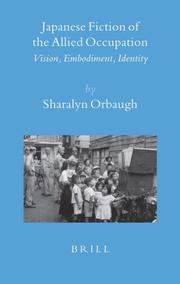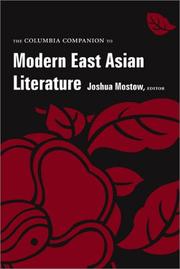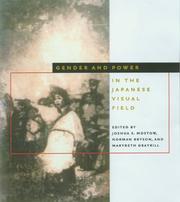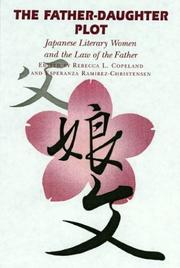| Listing 1 - 10 of 10 |
Sort by
|

ISSN: 09256512 ISBN: 9004155465 9789004155466 9786611458096 1281458090 9047411668 9789047411666 9781281458094 6611458093 Year: 2007 Volume: v. 26 Publisher: Leiden Boston Brill
Abstract | Keywords | Export | Availability | Bookmark
 Loading...
Loading...Choose an application
- Reference Manager
- EndNote
- RefWorks (Direct export to RefWorks)
The reconstruction of identity in post World War II Japan after the trauma of war, defeat and occupation forms the subject of this latest volume in Brill's monograph series Japanese Studies Library. Closely examining the role of fiction produced during the Allied Occupation, Sharalyn Orbaugh begins with an examination of the rhetoric of wartime propaganda, and explores how elements of that rhetoric were redeployed postwar as authors produced fiction linked to the redefinition of what it means to be Japanese. Drawing on tools and methods from trauma studies, gender and race studies, and film and literary theory, the study traces important nodes in the construction and maintenance of discourses of identity through attention to writers’ representations of the gaze, the body, language, and social performance. This book will be of interest to any student of the literary or cultural history of World War II and its aftermath. Japanese Fiction of the Allied Occupation was awarded Choice Outstanding Academic Title 2007 .
Japanese fiction --- Military occupation in literature --- J3389 --- J5930 --- Japanese literature --- History and criticism --- Japan: History -- Gendai, modern -- Shōwa period -- World War II -- occupation period (1945-1952) --- Japan: Literature -- modern fiction and prose (1868- ) --- Japan --- History --- Fictie. --- Tweede Wereldoorlog. --- History and criticism. --- Japan. --- Military occupation in literature.
Book
ISBN: 9004249443 9789004249448 9789004248823 900424882X Year: 2015 Publisher: Leiden
Abstract | Keywords | Export | Availability | Bookmark
 Loading...
Loading...Choose an application
- Reference Manager
- EndNote
- RefWorks (Direct export to RefWorks)
The first in-depth scholarly study in English of the Japanese performance medium kamishibai , Sharalyn Orbaugh’s Propaganda Performed illuminates the vibrant street culture of 1930's Japan as well as the visual and narrative rhetoric of Japanese propaganda in World War II. Emerging from Japan’s cities in the late 1920's, kamishibai rapidly transformed from a cheap amusement associated with poverty into the most popular form of juvenile entertainment, eclipsing even film and manga. By the time kamishibai died as a living medium in the 1970's it had left behind indelible influences on popular culture forms such as manga and anime, as well as on avant-garde cinema, theater, and art. From 1932 to 1945, however, kamishibai also became a vehicle for propaganda messages aimed not primarily at children, but at adults. A mixture of script, image, and performance, the medium was particularly suited to conveying populist, emotionally compelling messages to audiences of all classes, ages, and literacy levels, making it a crucial tool in the government’s efforts to mobilize the domestic populace in Japan and to pacify the inhabitants of the empire’s colonies and occupied territories. With seven complete translations of wartime plays, over 300 color illustrations from hard-to-access kamishibai play cards, and photographs of prewar performances, this study constitutes an archive of wartime history in addition to providing a detailed analysis of the rhetoric of political persuasion.
Kamishibai --- Sino-Japanese War, 1937-1945 --- World War, 1939-1945 --- Propaganda, Japanese --- War and theater --- War and society --- J6838 --- J4125 --- J4000.80 --- J3385 --- Society and war --- War --- Sociology --- Civilians in war --- Sociology, Military --- Theater and war --- Theater --- European War, 1939-1945 --- Second World War, 1939-1945 --- World War 2, 1939-1945 --- World War II, 1939-1945 --- World War Two, 1939-1945 --- WW II (World War, 1939-1945) --- WWII (World War, 1939-1945) --- History, Modern --- Chinese-Japanese War, 1937-1945 --- Japan-China War, 1937-1945 --- Japanese-Chinese War, 1937-1945 --- Second Sino-Japanese War, 1937-1945 --- Sino-Japanese Conflict, 1937-1945 --- Japanese propaganda --- Children's theater --- Street theater --- History and criticism --- Propaganda --- History --- Japan: Performing arts and entertainment -- kamishibai, picture stories, shadow plays --- Japan: Sociology and anthropology -- propaganda --- Japan: Social history, history of civilization -- Gendai (1926- ), Shōwa period, 20th century --- Japan: History -- Gendai, modern -- Shōwa period -- World War II -- invasion of Asia (1931-1945) --- Social aspects --- Japan --- Social life and customs --- E-books --- History and criticism. --- Propaganda. --- Art and the war.

ISBN: 0231113145 0231507364 0585473218 Year: 2003 Publisher: New York : Columbia University Press,
Abstract | Keywords | Export | Availability | Bookmark
 Loading...
Loading...Choose an application
- Reference Manager
- EndNote
- RefWorks (Direct export to RefWorks)
This extraordinary one-volume guide to the modern literatures of China, Japan, and Korea is the definitive reference work on the subject in the English language. With more than one hundred articles that show how a host of authors and literary movements have contributed to the general literary development of their respective countries, this companion is an essential starting point for the study of East Asian literatures. Comprehensive thematic essays introduce each geographical section with historical overviews and surveys of persistent themes in the literature examined, including nationalism, gender, family relations, and sexuality. Following the thematic essays are the individual entries: over forty for China, over fifty for Japan, and almost thirty for Korea, featuring everything from detailed analyses of the works of Tanizaki Jun'ichiro and Murakami Haruki, to far-ranging explorations of avant-garde fiction in China and postwar novels in Korea. Arrayed chronologically, each entry is self-contained, though extensive cross-referencing affords readers the opportunity to gain a more synoptic view of the work, author, or movement. The unrivaled opportunities for comparative analysis alone make this unique companion an indispensable reference for anyone interested in the burgeoning field of Asian literature. Although the literatures of China, Japan, and Korea are each allotted separate sections, the editors constantly kept an eye open to those writers, works, and movements that transcend national boundaries. This includes, for example, Chinese authors who lived and wrote in Japan; Japanese authors who wrote in classical Chinese; and Korean authors who write in Japanese, whether under the colonial occupation or because they are resident in Japan. The waves of modernization can be seen as reaching each of these countries in a staggered fashion, with eddies and back-flows between them then complicating the picture further. This volume provides a vivid sense of this dynamic interplay.
East Asian literature --- Oriental literature --- Asian literature --- Asia --- Study and teaching.
Book

ISBN: 9780231507363 Year: 2003 Publisher: New York, NY
Abstract | Keywords | Export | Availability | Bookmark
 Loading...
Loading...Choose an application
- Reference Manager
- EndNote
- RefWorks (Direct export to RefWorks)
Digital
ISBN: 9780231507363 9780231507363 Year: 2003 Publisher: New York, N.Y. Columbia University Press
Abstract | Keywords | Export | Availability | Bookmark
 Loading...
Loading...Choose an application
- Reference Manager
- EndNote
- RefWorks (Direct export to RefWorks)
Book

ISBN: 0824841573 9780824841577 Year: 2003 Publisher: Honolulu
Abstract | Keywords | Export | Availability | Bookmark
 Loading...
Loading...Choose an application
- Reference Manager
- EndNote
- RefWorks (Direct export to RefWorks)
In this, the first collection in English of feminist-oriented research on Japanese art and visual culture, an international group of scholars examines representations of women in a wide range of visual work. The volume begins with Chino Kaori's now-classic essay "Gender in Japanese Art," which introduced feminist theory to Japanese art. This is followed by a closer look at a famous thirteenth-century battle scroll and the production of bijin (beautiful women) prints within the world of Edo-period advertising. A rare homoerotic picture-book is used to extrapolate the "grammar of desire" as represented in late seventeenth-century Edo. In the modern period, contributors consider the introduction to Meiji Japan of the Western nude and oil-painting and examine Nihonga (Japanese-style painting) and the role of one of its famous artists. The book then shifts its focus to an examination of paintings produced for the Japanese-sponsored annual salons held in colonial Korea. The postwar period comes under scrutiny in a study of the novel Woman in the Dunes and its film adaptation. The critical discourse that surrounded women artists of the late twentieth-century--the "Super Girls of Art"--is analyzed, followed by a consideration of gender ambiguity and cross-gender identification in contemporary anime and manga.


ISBN: 9780824841577 9780824825720 Year: 2003 Publisher: Honolulu, Hawaii University of Hawaii Press
Abstract | Keywords | Export | Availability | Bookmark
 Loading...
Loading...Choose an application
- Reference Manager
- EndNote
- RefWorks (Direct export to RefWorks)
Multi

ISBN: 9780824863760 Year: 1999 Publisher: Honolulu, Hawaii University of Hawaii Press
Abstract | Keywords | Export | Availability | Bookmark
 Loading...
Loading...Choose an application
- Reference Manager
- EndNote
- RefWorks (Direct export to RefWorks)
Book

ISBN: 9780824864712 Year: 2001 Publisher: Honolulu
Abstract | Keywords | Export | Availability | Bookmark
 Loading...
Loading...Choose an application
- Reference Manager
- EndNote
- RefWorks (Direct export to RefWorks)


ISBN: 9780824864712 9780824821722 Year: 2001 Publisher: Honolulu, Hawaii University of Hawaii Press
Abstract | Keywords | Export | Availability | Bookmark
 Loading...
Loading...Choose an application
- Reference Manager
- EndNote
- RefWorks (Direct export to RefWorks)
| Listing 1 - 10 of 10 |
Sort by
|

 Search
Search Feedback
Feedback About UniCat
About UniCat  Help
Help News
News